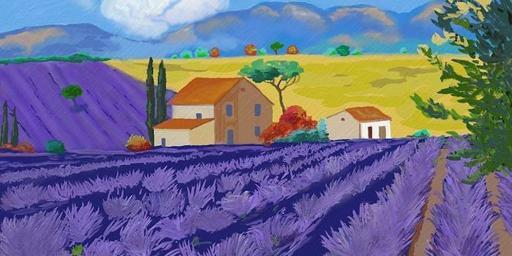Exploring the Lavender Fields of Provence
Lavender Fields of Provence
Rows of fragrant lavender plants stretching toward the horizon are an unforgettable sight. In fact, for many people, this is the first image that comes to mind when they think of Provence. You might imagine that the landscape has always been swathed in lines of lavender, but you would be wrong. Growing the purple plant in this fashion only began in the twentieth century.
Since time immemorial, wild lavender, called lavande, has dotted Provence’s rocky hilltops where shepherds and local peasants gathered it for their personal use. But when the University of Montpellier began to research lavender’s medicinal uses in the eighteenth century, demand for the aromatic herb rose. Crews of women and children, armed with cloth bags, departed daily to wander around the mountaintops gathering flowers from wild lavender plants. It was a time-consuming and inefficient method of harvesting. Continue reading here to learn about the lavender legend a contributor blog post by Margo Lestz – The Curious Rambler.
Harvesting Lavender in Provence
It’s hard to believe but it wasn’t until the 1950s that mechanical harvesting via tractor began. These old tractors had special blades to cut the lavender as they moved along the rows. The cut flowers tied by the machine and left in small bunches to dry in the sun. Today, there are harvesting machines that cut and roll the plants into big bundles. This process saves time, but the aficionados believe the essential oil at the end of the distilling process is less pure.
Pure lavender oil is expensive and there are many poor-quality products on the market. Having participated in the harvest and watched the distillation process, it’s easy to appreciate how much lavender needs to be grown to produce that little vial of essential oil. Here, is a guide to lavender in Provence.
Distilling Lavender
Here, is a summary of the distillation process for traditional lavender growers:
- The flowers are cut, bundled and left to dry in the field for 1-2 days.
- Tractors loaded with dried bundles haul their purple loads to the distillery.
- This is where the bales of flowers are stuffed into enormous vats. It is incredibly hard work, but you smell terrific at the end of the day.
- Once the vat lids are closed, steam is pumped through the tubes (think large pressure cookers) until the flowers are hot enough to release their essence.
- This liquid has two components; a clear heavily scented essence and a fractional amount of essential oil. Both parts are collected and sold for commercial use.
When the lavender is harvested in Provence at the end of July, a heavenly scent is carried on warm evening breezes. Alerted by the first wafts of perfumed air, from our terrace we can sometimes see the smoke rising from the other side of a small ridge. The distillation has begun.
In the small purple fields woven into the landscape of the hills around the town of Apt in the Luberon, the stills are sometimes placed in the very fields where the flowers have been grown. In this part of Provence lavender farming is a far cry from the huge commercial concerns of Sault and Valensole, more like smallholdings tended in the traditional way.

Lavender Festivals
Depending on the weather in the spring, the lavender fields may begin flowering in late June. The flowers are often in full bloom by early July, but that does not mean the celebrations are over. Here, a few of the lavender-themes festivals.
Apt: Fête de la Lavande takes place on a Sunday around the middle of July.
Valensole: Often considered THE place to go and see the lavender fields in Provence. To celebrate the harvest la fête de la lavande de Valensole takes place the 3rd Sunday in July.
Alpes-Maritimes: Fête de la Lavande de Sainte Agnès is typically on the last weekend of July.
Sault: Wraps up the season each year with the final lavender festival on August 15th. La Fête de la lavande de Sault is a full day of purple fun.



No Comment